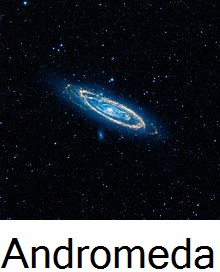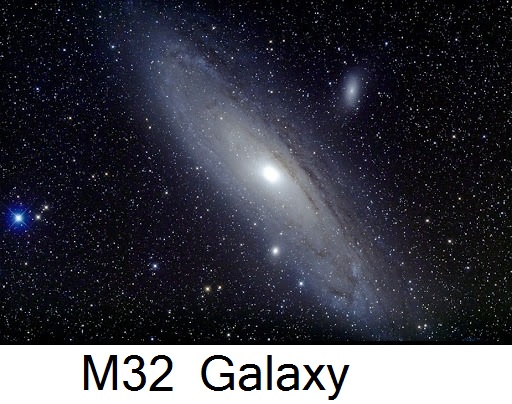Today
we are going to discuss about Andromeda Galaxy, the nearest galaxy to our own
Milky Way Galaxy. We know this galaxy by different names such as Messier-31 or
M-31 or NGC-224 or Andromeda Nebula. This spiral galaxy, 2.5
million light-years or 25 lakhh light-years or 770 kilo parsec away from Earth,
is named after the Phoenician princess and the wife of Perseus of Greek
mythology.

If
we talk about the observations and researches of the people of this galaxy,
then it can be seen that for the last nearly one and a half thousand years,
many scientists have studied this galaxy at different times and tried to
present the true form of Andromeda to us. The first attempt in this direction
was made by the Persian astronomer Abd-al-Rehman-al-Sufi. In 964 AD, he shed
light on this subject in his astronomical documents. Although initially thought
to be a structure, similar to other small clouds with stars in space, Andromeda
gave the earliest description in 1612 by observing it with the help of a
telescope by the German astronomer Simon Marius. In 1745, Pierre-Louis
Maupertuis described the galaxy as an 'Island Universe'. In 1764, Charles
Messier re-observed Andromeda. This galaxy is named after him as Messier-31 or M-31.
Shortly afterwards, in 1785, William Herschel first discovered a faint red
light at the centre of the galaxy. Half a century later, in 1850, William
Parsons, or the 3rd Earl of Rosses, first attempted to draw the Andromeda
structure. In 1864, William Higgins tried to learn about Andromeda with the
help of the spectrum of light. The first supernova of a star in this galaxy was
found in 1885, which scientists named S-Andromeda. Isaac Roberts was the first
person to photograph Andromeda in 1888. In 1912, Vesto Slipher measured the
velocity of an object in this galaxy with a value of 300 km/sec. Radio rays
from the galaxy were first identified in 1950 by Hanbury Brown and Cyril Hazard
and John Baldwin made the map of Andromeda with the help of radio waves in the
1950s, and in 2001 a planet in that galaxy was discovered.




Scientists
have estimated that the Andromeda galaxy was born at least 10 billion or 1,000
crore years ago. The form Andromeda we see today is actually a combination of
Andromeda and many other smaller galaxies that Andromeda has attracted to
itself in the past under the influence of its intense gravitational force. As
an example of a smaller galaxy, we can name the M32 or M111 galaxy. At that
time the rate of star formation in the galaxy was very high but over the last 2
billion or 200 crore years the rate of star formation has dropped
significantly. If the age of the Andromeda galaxy is compared with our galaxy,
it can be seen that Andromeda is a little older. So while our galaxy may
produce stars of 3 to 5 solar masses per year, Andromeda is producing stars
approximately 1 solar mass per year. If this continues, perhaps after 5 billion
or 500 crore years, Andromeda will cease to produce stars completely. It is
virtually impossible to accurately determine the total mass of a galaxy. Yet
scientists estimate that the mass of Andromeda is between 25 to 50 percent of
our galaxy. At first it was thought that the mass of these two galaxies was
equal. Then the numbers showed that the mass of our galaxy is 8X1011
times the mass of the Sun and the mass of Andromeda is 1.5X1012
times the mass of the Sun. Studies in 2019 have shown that the mass of our
galaxy is 1.5X1012 times the mass of the Sun and the mass of
Andromeda is 0.8X1012 times the mass of the Sun. According to
current estimates, the weight of Andromeda is more than 2X1042 kg.

The
distance between Andromeda and Earth mentioned earlier has been determined with
the help of various modern methods such as TRGB method (The Tip of The Red
Giant Branch), CVM method (Cepheid Variable Method) or ISBF method (Infrared
Surface Brightness Fluctuation) etc.
The
mass of hydrogen in the Interstellar Region of the Andromeda galaxy is 7.2X109
times the mass of the Sun. (Interstellar Region: The vast region
between two or more stars in a galaxy where gas is in ionized, atomic state or
in stabled formed along with cosmic rays and dust.) The most astonishing
information is that, the mass of hot gas that surrounds this galaxy is half the
total mass of the galaxy. This surrounding layer extends from the main galaxy
to 1 million or 10 lakh light-years, and this distance is about half the
distance of our galaxy from Andromeda. Particles of heavier material than
hydrogen and helium have been found in this heated coating. It is estimated
that during the lifetime of this galaxy, about 50 percent of the heavy matter,
produced by the stars within it ,will be thrown within a distance of 2,00,000
light-years from the galaxy.
This
galaxy, with a diameter of 2,00,000 light-years or 67 kilo parsec, is 2X1010
times brighter than our Sun in terms of brightness, which is 25 percent more
than our own galaxy. However, we need to keep in mind that dust in the
interstellar region absorbs a lot of unknown light rays, so determining the
correct brightness is a very difficult task. However, based on observations
from the Spitzer Space Telescope, it was announced in 2010 that the brightness
value of the Andromeda galaxy was -20.69. The point to note here is that the
smaller the brightness values of an object in space, the greater the brightness
of the object.

One
more thing we need to keep in mind here is that since our galaxy is much more
active than Andromeda, its star-producing capacity is higher, there will come a
time in the future when our galaxy will surpass Andromeda in terms of
brightness. The star-producing capacity of a galaxy decreases only when the
star-producing substances in its interstellar region decrease. Andromeda is now
able to produce very few stars so this galaxy is now called the Green Valley
galaxy.
It
is found that in 2005, this spiral galaxy, classified as SA, is at least three
times wider, than previously thought. This galaxy is one of the largest in the
local galaxy cluster where Andromeda is located in space. The number of stars
in this galaxy is approximately 1 trillion or 1 lakh crore.
The
arms of this galaxy were first observed by Walter Baade. According to him, the
two arms of this galaxy are wider than our galaxy, though there is disagreement
about this. Many scientists think that, this galaxy is changing into a ring
galaxy little by little according to the laws of evolution. According to them,
a dust and gas ring was observed 32,000 light-years from the centre of
Andromeda. The ring is thought to have formed from the time when a small galaxy
called M-32 was pulled towards itself due to intense gravitational force.
Scientists estimate that Andromeda has so far pulled 100 to 200 low-mass
galaxies under its intense gravitational force.

At
the centre of the Andromeda, there are two star-rich dense regions called P-1
and P-2. P-1 is 4.9 light years away from the main centre. There is no black
hole in this star-rich region. P-2 is located at the very centre point. At the
centre of this P-2 region, there is a black hole whose mass can be between 1.1
X 108 to 2.3 X 106 times the mass of the Sun. Here the
rotational speed of objects is 160 km per second. Different places in this
galaxy have different rotational speeds. For example, at 1,300 light-years from
the centre, its value is 225 km per second, at a distance of 7,000 light-years
it decreases to 50 km per second. At the distance of 33,000 light-years it
increases to 250 km per second and at 88,000 light-years it rotates at 200 km
per second. Scientists also found no X-ray source from Andromeda at first, but
later XMM Orbiting Observatory, NuSTAR Space Telescope, Chandra X-Ray
Observatory and Soft Gamma Ray Burst Observatory have provided a large number
of X-ray sources.



The
Andromeda galaxy contains more than 460 round clusters of stars, the largest
and brightest being Mayall or Globular-1 or G-1. This constellation is twice as
bright as Omega Centauri, the brightest constellation in our Milky Way galaxy.
Many think that this G-1 was a galaxy in the past that Andromeda pulled towards
itself by its strong gravitational force, and what is now visible to our eyes
is actually a remnant of that galaxy of the past. In its turn, a similar
cluster of stars was found here in which the density of the stars is
comparatively less because of its much larger spread. In addition, more than 20
dwarf galaxies or satellite-like galaxies have been found in Andromeda, like
our own galaxy. The most notable of these are M-32 and M-111. However, the
Tringulum galaxy, 7,50,000 light-years from Andromeda is doubtful whether it is
such a dwarf galaxy.


Andromeda
is located at an angle of 77 degree to the earth. This galaxy can be clearly seen
with the naked eye without binoculars or telescopes, even if there is dim light
all around on a moonless night. M-32 and M-111 like dwarf galaxies are also
visible with the help of binoculars of a slightly advanced nature, and much
more can be seen with the help of telescopes. It is best seen in autumn from
the Northern Hemisphere. The galaxy usually rises in the east in September, and
five months later, in the winter, goes down the western sky in February. In the
case of the Southern Hemisphere, Andromeda is best observed in October and
November.
The
most interesting information about Andromeda is that, this galaxy is
approaching our galaxy at a speed of 100 km per second or 3,60,000 km per hour.
This means that Andromeda travels 94 percent of the average distance between
Earth and the Moon every hour. If Andromeda will move forward at this speed,
the two galaxies would inevitably collide in the next 4 billion or 400 crore
years. This collision can result in the formation of large elliptical galaxy or
disc-like galaxy. This type of collision is a very common cosmic event in
space.
It is not possible to predict the future situation of the Earth and the solar system at that time. It is important to keep in mind that at that point in time, our sun will have passed 90 percent of its lifespan. If the sun attains the 'Red Giant' phase at that time, then the question of whether the earth will exist is a matter of million dollars. However, the chance of this solar family dropping out of its own galaxy is almost negligible. If human civilization can survive on another planet, dwarf planet or satellite, then only they can feel the direct and indirect effects of this cosmic event.

DECLARATION: All The Images Have Been Sourced From Google.
